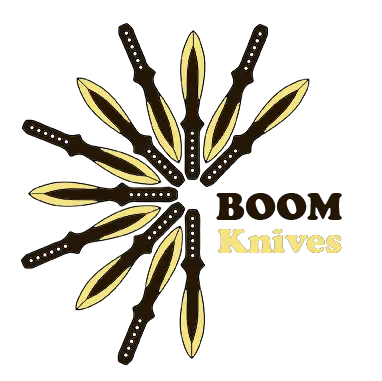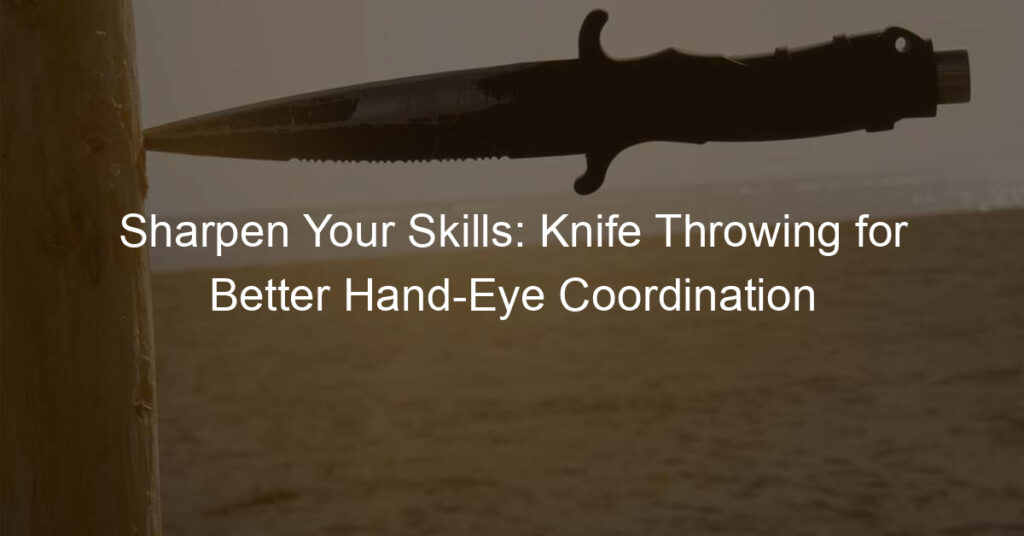Introduction to Knife Throwing
-
- What is Knife Throwing?
Is an art, a sport, and a survival skill that has been practiced for centuries. It involves precisely throwing a knife at a target, aiming to hit it accurately. The knife used for this purpose is typically a specially designed throwing knife, which is balanced and weighted to ensure a straight and stable flight when thrown properly.
-
- Why is Knife Throwing fascinating?
It requires a high level of skill and concentration, making it a challenging and rewarding pursuit. It’s a versatile activity that can be enjoyed both indoors and outdoors, alone or with friends. It’s a unique hobby that stands out from more common pastimes, making it a great conversation starter. The thrill of hitting the target after mastering the technique is an exhilarating feeling that keeps enthusiasts coming back for more.
Knife Throwing History
-
Origins of Knife Throwing
Early humans used thrown knives as hunting tools. The practice was later adopted for combat and entertainment purposes. The first recorded instance of knife throwing in a performance setting was in ancient Egypt, around 2000 BC.
-
Evolution of Knife Throwing Techniques
The thrower would typically stand close to the target and use a simple overhand throw. As the art developed, throwers started to incorporate spin techniques, which involve the knife rotating in the air before hitting the target. Today, there are various styles of knife throwing, including no-spin, rotational, and instinctive throwing, each requiring a different set of skills and techniques.
Basics of Knife Throwing
Knife Throwing Techniques
- Basic Knife Throwing Techniques
-
- Handle Grip: This is the most common grip for beginners. You hold the knife by the handle and throw it towards the target.
- Blade Grip: In this technique, you hold the knife by the blade and throw it. This technique requires more control and precision.
- Half Spin Throw: This is a beginner-friendly technique where the knife makes a half rotation before hitting the target.
-
- Advanced Knife Throwing Techniques
-
-
- Full Spin Throw: In this technique, the knife makes a full rotation before hitting the target. It requires a good understanding of distance and rotation.
- No Spin Throw: This is a difficult technique where the knife doesn’t spin at all. It requires a lot of control and precision.
- Multiple Knife Throw: This is a technique where you throw multiple knives at once. It requires excellent coordination and timing.
-
Knife Throwing Equipment
- Types of Throwing Knives
-
- Blade-Heavy Knives: These knives have a heavier blade than handle, making them easier to throw by the blade. They are great for beginners.
- Handle-Heavy Knives: These knives have a heavier handle, which makes them ideal for throwing by the handle. They require a bit more skill to use effectively.
- Balanced Knives: These knives have an equal weight distribution between the blade and handle. They are versatile and preferred by professionals.
-
- Choosing the Right Equipment
-
- Consider Your Skill Level: Beginners should start with blade-heavy knives, while more experienced throwers might prefer balanced knives.
- Think About Your Throwing Style: If you prefer to throw by the handle, choose a handle-heavy knife. If you like to throw by the blade, a blade-heavy knife might be better.
- Test Different Knives: The best way to find the perfect knife is to try out different types. This will help you understand what feels most comfortable and works best for you.
-
Knife Throwing for Beginners
Getting Started
A good throwing knife should be balanced, sturdy, and the right weight for you. It’s recommended to start with a knife that’s between 12 to 16 ounces in weight and 12 to 14 inches in length. This size is manageable for beginners and allows for a good grip. Avoid knives with sharp edges or points, as they can cause injury. Instead, opt for a knife with a blunt edge and a sharp point.
-
- Understanding Safety Measures
Always ensure that your practice area is clear of people and pets. Wear protective gear, including safety glasses and sturdy shoes. Never throw a knife when someone is in front of you or in your throwing line. Always handle your knife by the handle, not the blade. The more you practice, the better you’ll get at controlling your throws and ensuring safety.
Practicing Your Throw
-
- Setting Up Your Practice Area
This area should be free from obstructions and bystanders. A large, open space with a sturdy target is ideal. The target can be made from soft wood, like pine, and should be at least 16 inches in diameter. Ensure the ground around the target is soft to prevent the knife from bouncing back if it misses the target.
-
- Improving Your Technique
Start by standing about 10 feet away from your target. Hold the knife by the handle, with your thumb on one side and your fingers on the other. Your grip should be firm but relaxed. Swing your arm back over your shoulder, then forward in a smooth motion, releasing the knife as your arm comes down. The key is to throw the knife, not flick it. The knife should spin end over end and stick in the target. Don’t get discouraged if you miss; even professional throwers miss sometimes. Practice regularly, and you’ll see improvement over time.
Professional Knife Throwing
Competitive Knife Throwing
-
- Understanding Knife Throwing Competitions
Knife throwing competitions are events where participants throw knives at a target from a set distance. The aim is to hit the target as accurately as possible. The International Knife Throwers Hall of Fame (IKTHOF) sets the rules and standards for these competitions. Scoring is based on where the knife lands on the target, with the bullseye usually worth the most points.
-
- Training for Competitions
Training for a knife throwing competition requires dedication and consistency. It involves mastering the basics of knife throwing, such as grip, stance, and throwing technique. Practicing regularly is key to improving accuracy and precision.
Knife Throwing as a Career
-
- Pros and Cons of Professional Knife Throwing
Like any career, professional knife throwing has its ups and downs. Let’s take a closer look.
| Pros | Cons |
|---|---|
| Unique and exciting career | Requires intense training and practice |
| Potential for fame in niche communities | Not a widely recognized profession |
| Opportunity to travel for competitions | Potential risk of injury |
-
- Success Stories in the Field
-
-
- Adam Celadin: A five-time World Champion in knife throwing, Adam Celadin is a shining example of success in this field. He has dedicated his life to the sport and has reaped the rewards of his hard work.
- Annette Zielinski: Known as the “Queen of Blades”, Annette has made a name for herself in the world of knife throwing. Despite being one of the few women in the field, she has won multiple championships and is a respected figure in the community.
-
Fun Facts about Knife Throwing
-
- Interesting Knife Throwing Trivia
Did you know that knife throwing has been around for over 2,000 years? It was first practiced by the ancient Egyptians and Greeks. Today, it’s enjoyed by people all over the world, both as a sport and as a form of entertainment.
Here’s another fun fact: the type of knife used in throwing can greatly affect the outcome. The weight, size, and balance of the knife all play a role in how well it flies and sticks to the target. That’s why professional throwers often have a collection of knives to choose from, depending on the situation.
And did you know that there’s a International Knife Throwing Hall of Fame? It was established in 2003 to honor those who have made significant contributions to the sport.
-
- World Records in Knife Throwing
There are several world records related to knife throwing. For instance, the record for the most knives thrown in one minute is held by David Adamovich, who threw 102 knives in 60 seconds. That’s almost two knives per second!
The longest successful knife throw is another impressive record. On July 22, 2018, Che Che WhiteCloud of the USA threw a knife a whopping 21.41 meters (70.18 feet) to hit a target, setting a new world record.
And let’s not forget about the youngest professional knife thrower. At just six years old, Grennan Bartlett-Nealeigh became the youngest professional knife thrower in the world. He even performed on the popular TV show, America’s Got Talent.
Knife Throwing Safety Tips
- Importance of Safety in Knife Throwing
Knife throwing involves handling sharp objects, which, if not done correctly, can lead to serious injuries. It’s not just about protecting yourself, but also those around you. A stray knife can cause harm to spectators or even damage property. Moreover, a safe approach to knife throwing also increases your efficiency and accuracy in the sport. It’s essential to understand that safety isn’t a choice, but a necessity in knife throwing.
- Top Safety Tips for Knife Throwin
-
-
- Use the Right Equipment: Always use knives designed for throwing. These are balanced and designed to be thrown safely.
- Check Your Surroundings: Ensure you have a clear, safe space to throw. Keep spectators at a safe distance.
- Handle with Care: Always handle knives with care. Never run with a knife in your hand or point it at someone.
- Practice Makes Perfect: Practice your throws to increase accuracy and reduce the chance of accidents.
- First Aid: Always have a first aid kit nearby in case of any accidents.
-
Conclusion: The Art of Knife Throwing
-
- Recap of Key Takeaways
Our exploration began with an introduction to knife throwing, where we discovered its rich history and the basics of the sport. We learned about the techniques beginners should master, and the dedication required to reach a professional level. We also delved into some fun facts about knife throwing and emphasized the importance of safety measures.
From the correct grip and stance to the precise release, we’ve learned that knife throwing is a sport of precision and control. The journey from a beginner to a professional requires patience, practice, and a deep understanding of the principles of knife throwing.
-
- Final Thoughts on Knife Throwing
Knife throwing is more than just a sport or a hobby. It’s an art form that requires dedication, precision, and a deep understanding of the physics involved. It’s a journey of self-improvement and discipline, where every throw is a lesson learned.







